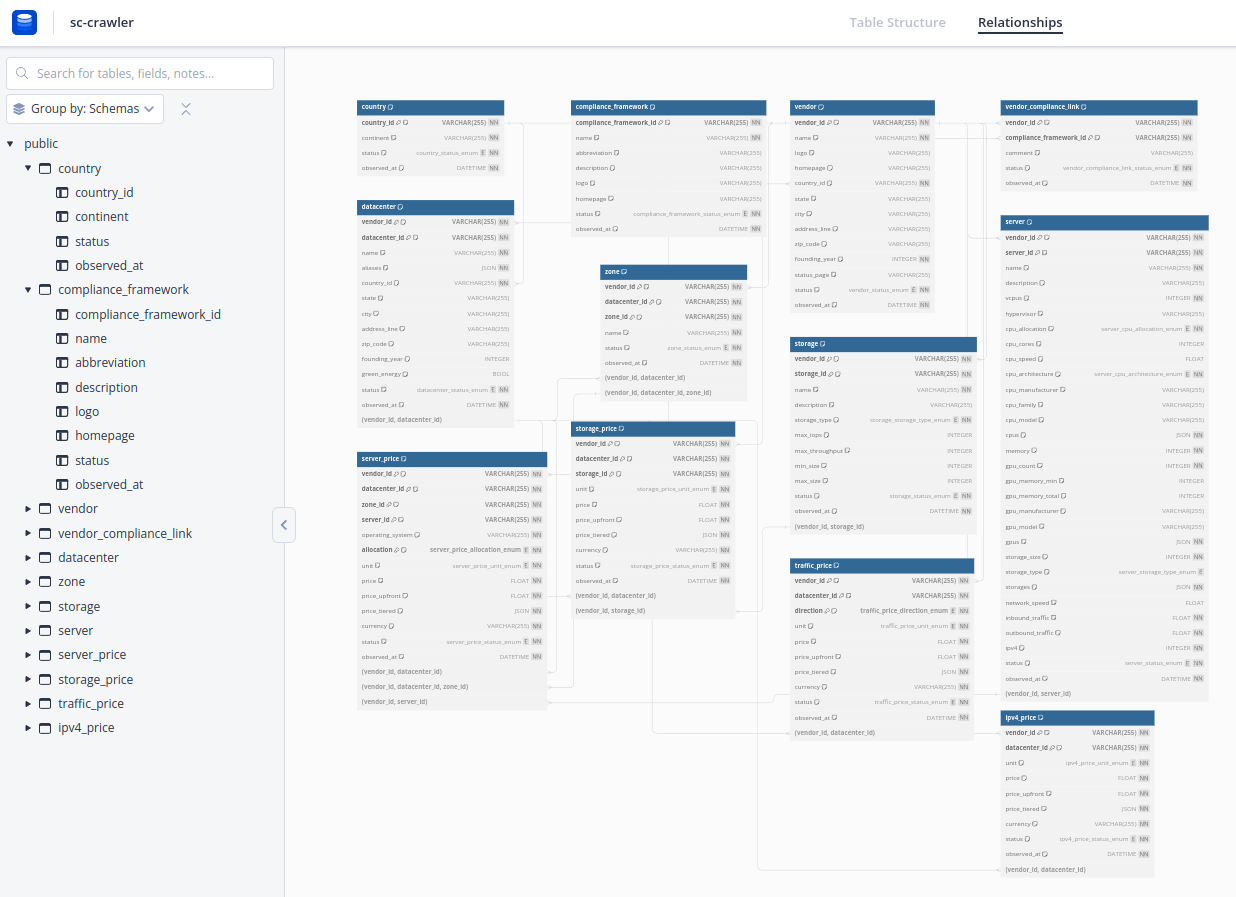Each vendor has its nomenclature on the compute resources (e.g. "spot instances" versus "preemptible servers"), but we were hoping that we can standardize all these across the vendors in the Spare Cores ecosystem.
This required us to make some arbitrary decisions (e.g. we went with the "server with spot allocation" naming schema and decided not to inventory reserved instance pricing at this time), and seeing the inconsistencies between vendors early on, it became very clear that how things are called might change at any point even within a single vendor, so thus we should stick with unique and stable identifiers in all cases.
But do vendors support that? Let's review this using an important concept that exists in almost all supported vendors: availability zones!
Hetzner Cloud #
Hetzner has five datacenters across Europe and USA, but they have not
implemented separated zones within a datacenter. This put us in a
difficult situation, as the SC Crawler schemas require the presence of
zone_id e.g. for server prices, so we decided to create "pseudo
zones": one zone for each datacenter, using the same id and name.
Anyway, what we have learned about their ids and names? The resource ids are integers, e.g. the CX family using up single-digit odd numbers, and the CCX family the range from 96 to 101:
SELECT server_id, name, vcpus, memory
FROM server
WHERE vendor_id = 'hcloud' AND name LIKE '%CX%'
ORDER BY CAST(server_id as INTEGER);
| server_id | name | vcpus | memory |
|---|---|---|---|
| 1 | cx11 | 1 | 2048 |
| 3 | cx21 | 2 | 4096 |
| 5 | cx31 | 2 | 8192 |
| 7 | cx41 | 4 | 16384 |
| 9 | cx51 | 8 | 32768 |
| 96 | ccx13 | 2 | 8192 |
| 97 | ccx23 | 4 | 16384 |
| 98 | ccx33 | 8 | 32768 |
| 99 | ccx43 | 16 | 65536 |
| 100 | ccx53 | 32 | 131072 |
| 101 | ccx63 | 48 | 196608 |
Honestly, you better rely on the server names to identify what
hardware is covered. Fortunately, this is very well supported by their
API SDKs, e.g. the Python client provides an id_or_name helper so
that the user or program can use whatever they wish.
Amazon Web Services #
AWS uses human-friendly strings as the resource identifiers that are easy to remember and identify, and those are actually matching the name in some cases, e.g. for the servers.
Unfortunately, it's not that straightforward when it comes to other resource types.
The region_id is an all lowercase text starting with a 2-letter
continent reference, then location reference and a number; while the
name is a title-case string with the a city or state name in
parenthesis after the continent. Unfortunately, the region names
are not always used consistently throughout all the AWS API endpoints,
e.g. "Europe" often get abbreviated as "EU", so we recorded these as
aliases for the region names that we can look up:
SELECT region_id, name, aliases
FROM region
WHERE vendor_id = 'aws'
ORDER BY RANDOM()
LIMIT 10;
| region_id | name | aliases |
|---|---|---|
| cn-northwest-1 | China (Ningxia) | [] |
| eu-west-2 | Europe (London) | ["EU (London)"] |
| ap-south-1 | Asia Pacific (Mumbai) | [] |
| ap-southeast-3 | Asia Pacific (Jakarta) | [] |
| eu-north-1 | Europe (Stockholm) | ["EU (Stockholm)"] |
| us-east-2 | US East (Ohio) | [] |
| ap-southeast-2 | Asia Pacific (Sydney) | [] |
| ap-east-1 | Asia Pacific (Hong Kong) | [] |
| eu-west-1 | Europe (Ireland) | ["EU (Ireland)"] |
| eu-central-1 | Europe (Frankfurt) | ["EU (Frankfurt)"] |
This is a bit painful, but manageable problem: we have been maintaining the list of aliases manually in the SC Crawler package, and we keep our fingers crossed for no breaking changes.
But availability zones have another interesting fact:
"AWS maps the physical Availability Zones randomly to the Availability Zone names for each AWS account."
In other words, when the SC Data database refers to the "us-east-1b" zone,
that might be actually called "us-east-1b" or "us-east-1f" etc in your
account! Fortunately, the zone_id field is a reliable mapping even
between different organizations, so when we say that an instance is
the cheapest in the use1-az3 zone, you should be able to reference
that in your AWS account, for example with the following command:
aws ec2 \
--region us-east-1 describe-availability-zones \
--output text \
--query 'AvailabilityZones[?ZoneId==`use1-az1`].ZoneName'
Google Cloud Platform #
To keep it short, GCP is a mix of the above-described words:
- Using integers for the ids (e.g.
region_ids are between 1000 and 2000,zone_ids are between 2000 and 3000 etc), - Human-friendly zone names are not interchangeable between GCP accounts.
What might be surprising is that there is no way to map an actual availability zone with another GCP accounts' zone (except for a few special cases):
"Compute Engine implements a layer of abstraction between zones and the physical clusters where the zones are hosted. A cluster represents a distinct physical infrastructure that is housed in a data center. Each zone is hosted in one or more clusters and Compute Engine independently maps zones to clusters for each organization."
This was highly confusing first, as we were trained using AWS with very different prices even between the availability zones of a single region, but as GCP has uniform prices within a region, it did not raise any issues after all (except for storing redundant data in our databases).
Takeaway #
As you can see, there are very different patterns when it comes to using resource ids and names, but the Spare Cores project has always found a way to standardize into a useful data structure so far.
If interested in more details, check out the SC Crawler docs, or head over directly to the database schema documentation:

